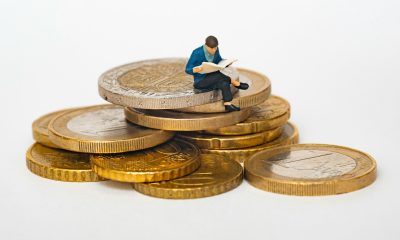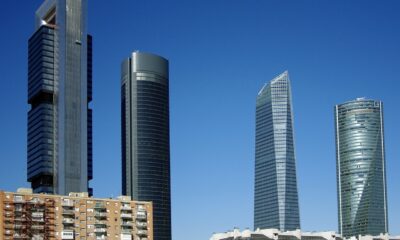Business
Spain’s GDP Dodges Recession with a Growth of 5.5% in 2022
Although the advance in Spain’s GDP compared to the immediately preceding quarter has been better than expected, the economic standstill is evident. A look at the graph of the quarterly variation of the GDP, shows the strong growth that it had been registering from the second quarter of 2021, to fall in the first quarter of last year and then remain at 0.2% in both the third and fourth quarters of this year

Spain’s gross domestic product (GDP) finally dodged the stagnation that analysts were predicting for the last quarter of the year, thus boosting its advance for the year as a whole. According to data published this Friday by INE, GDP grew by 0.2% in the fourth quarter, bringing the 2022 figure to 5.5%. This is a much higher figure than that estimated by economists as a whole, better also than that forecast by the Government itself, and identical to the growth recorded in the 2021 financial year.
The Executive expected economic growth of 4.4%, i.e. 1.1 points below the figure advanced today by the INE, which will be confirmed on March 24. “In an international context of great uncertainty, marked by the consequences of Russia’s war in Ukraine, the Spanish economy has shown great solidity and resilience,” the Ministry of Economic Affairs and Digital Transformation congratulated itself. The Bank of Spain expected growth of 4.6%, and the average of the set of economic institutions – compiled by Funcas – was at 5%, after revising them upwards several times throughout the year.
Read more about Spain’s GDP and find the latest economic news from around the world with the Born2Invets mobile app.
Even so, Spain has not yet recovered from the level of GDP it had before the coronavirus pandemic
That is, citizens have not recovered the per capita income levels they had in 2019. The rest of the European countries have reached this level, many of them, last year. And given the poor growth forecasts for this year, for now, it is not possible for Spain to reach this barrier in 2023.
In spite of the fact that the advance in Spain’s GDP compared to the immediately preceding quarter has been better than expected (it was expected to remain at 0.0%, and also to fall back), the economic standstill is evident. If we look at the graph of the quarterly variation of the GDP, we can see the strong growth that it had been registering from the second quarter of 2021, to fall in the first quarter of last year and then remain at 0.2% in both the third and fourth quarters of this year, when economists were predicting that it could fall back.
For the Government, the data are very positive in a context of very strong prices, very complicated at the international level due to Russia’s invasion of Ukraine and of strong rises in interest rates, as the Secretary of State for Economy, Gonzalo García Andrés, pointed out this Thursday in a press conference after the publication of the EPA data. It should be remembered that in 2022 prices shot up by 8.4% compared to those of the previous year, a level not seen since 1986, with the corresponding impact on families and companies.
However, yesterday’s EPA data, for its part, confirmed the standstill. Unemployment rose and workers fell in the fourth quarter, although the balance of the year was positive, with a job creation of 279,000 people. This is a much slower pace than in previous years, without taking into account 2020, due to the pandemic, which, together with the GDP data, leads one to wonder what will happen in the coming months.
On the other hand, the INE has again corrected the data for previous quarters, as usual, raising the third quarter data by one tenth of a percentage point (to 0.2%) and the second quarter (2.2%) and lowering the first quarter (-0.01%). The rest of the data for previous years remain unchanged. These adjustments, taken together, have brought growth to an unexpected 5.5%, equal to that of the previous year.
Growth of Spain’s GDP, thanks to external demand
By component, domestic demand (which includes consumption and investment) contributed 2.8 percentage points to GDP growth, and external demand (which includes exports and imports), 2.6 points. The former contributed 2.4 points less than the previous year, but the latter contributed 2.3 points more. In this sense, the economy was sustained by the strength of the foreign sector, despite the slowdown in the domestic sector.
In the last quarter, and along the same lines, foreign demand contributed 1.3 points and domestic demand subtracted 0.9, mainly due to the fall in household consumption, which fell by 1.8%, although in the third quarter, it advanced by the same amount. Investment, on the other hand, fell by 3.8% in the last three months, and public spending rose by 1.9%. By sector, in the fourth quarter, all sectors grew except agriculture, and mostly construction (4.5%), services (3.6%), and, far behind, industry (0.5%).
__
(Featured image by Alex Azabache via Pexels)
DISCLAIMER: This article was written by a third party contributor and does not reflect the opinion of Born2Invest, its management, staff or its associates. Please review our disclaimer for more information.
This article may include forward-looking statements. These forward-looking statements generally are identified by the words “believe,” “project,” “estimate,” “become,” “plan,” “will,” and similar expressions. These forward-looking statements involve known and unknown risks as well as uncertainties, including those discussed in the following cautionary statements and elsewhere in this article and on this site. Although the Company may believe that its expectations are based on reasonable assumptions, the actual results that the Company may achieve may differ materially from any forward-looking statements, which reflect the opinions of the management of the Company only as of the date hereof. Additionally, please make sure to read these important disclosures.
First published in EL INDEPENDIENTE, a third-party contributor translated and adapted the article from the original. In case of discrepancy, the original will prevail.
Although we made reasonable efforts to provide accurate translations, some parts may be incorrect. Born2Invest assumes no responsibility for errors, omissions or ambiguities in the translations provided on this website. Any person or entity relying on translated content does so at their own risk. Born2Invest is not responsible for losses caused by such reliance on the accuracy or reliability of translated information. If you wish to report an error or inaccuracy in the translation, we encourage you to contact us.

-

 Africa1 week ago
Africa1 week agoBLS Secures 500 Million Dirhams to Drive Morocco’s Next-Gen Logistics Expansion
-

 Fintech2 weeks ago
Fintech2 weeks agoRipple Targets Banking License to Boost RLUSD Stablecoin Amid U.S. Regulatory Shift
-

 Impact Investing3 days ago
Impact Investing3 days agoSustainable Investments Surge in Q2 2025 Amid Green and Tech Rebound
-

 Biotech1 week ago
Biotech1 week agoBiotech Booster: €196.4M Fund to Accelerate Dutch Innovation

























